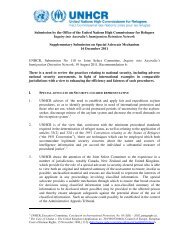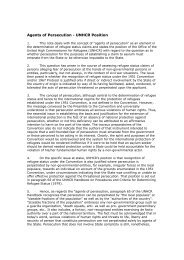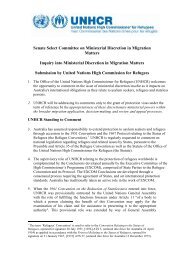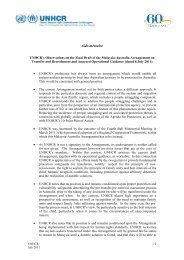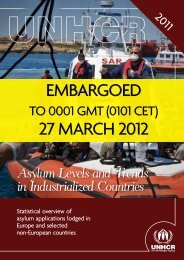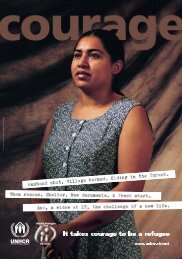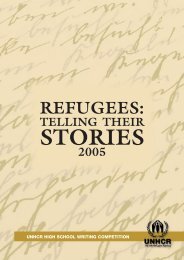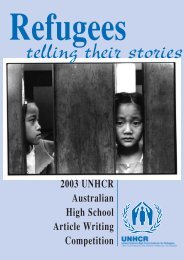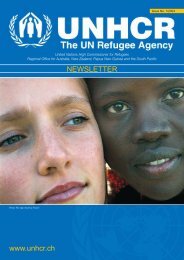From theRegionalRepresentativeContinued from page 1…New High Commissionerfor <strong>Refugee</strong>sThe amendments also provide asoftening of mandatory regulations forfamilies with children; faster processing ofTPVs; extended discretionary Ministerialpowers; and greater independent scrutinyof long term detention cases by theCommonwealth Ombudsman.Nevertheless, with regard to thesepositive developments, I feel it isimportant to take the opportunity toreiterate UNHCR's detention guidelines. 1Any detention of asylum-seekers is viewedglobally by UNHCR as inherentlyundesirable. This is even more so in thecase of vulnerable groups such as singlewomen, children, unaccompanied minorsand those with special medical orpsychological needs. While UNHCRrecognises that detention by States issometimes necessary to carry out health,identity and security checks, it should befor the shortest possible time andalternatives should be explored.This matter is, however, but oneamongst many echoes of real securityconcerns in today's world. Another is thegrowing need identified by theinternational community to developcomplementary forms of protection.In 2001, the concept of "complementaryprotection" was identified in UNHCR's"Agenda for Protection" as an importantnew tool. It is a concept which has beenfrequently debated since, and it will beaddressed once again at UNHCR'sExecutive Committee (EXCOM) meeting inGeneva this October. To help stimulatediscussion in this region, it is also thefocus of the discussion papers in this<strong>Newsletter</strong>, and I hope the variouscontributions from a range of perspectiveswill stimulate the interest of our readers.1. Copy of UNHCR's detention guidelines can be foundat www.<strong>unhcr</strong>.org.au/protlegalMr. António Guterres officially assumed hisduties as the 10th UN High Commissionerfor <strong>Refugee</strong>s on June 15, 2005, declaringsupport for the core values of internationalrefugee protection.The former Portuguese prime ministerwas nominated for the position on May 24by the Secretary-General Kofi Annan andformally elected three days later by UNGeneral Assembly to a five-year term.Addressing refugee agency staff on hisfirst day, Mr. Guterres said he had told Mr.Annan that he would be “firm in assertingthe core values of the office and thatrefugees and states alike should expect aprincipled, effective and committedUNHCR.”The new High Commissioner noted thatfinding safety in today’s world wasbecoming increasingly difficult. Whiledeveloping countries least able to afford ithost most of the world’s refugees, manyindustrialized nations continue to imposeever stricter controls on asylum.“All of us bear a responsibility forensuring that those genuinely in need ofinternational protection receive it,” he said,adding that more also needs to be donefor the estimated 20-15 million internallydisplaced people who are uprooted withinthe borders of their own countries.Less than a week into the new post, MrGuterres visited Uganda for World<strong>Refugee</strong> Day and to see for himself thesituation of refugees in northern Uganda,a country he praised for its generosity inhosting refugees. He visited Palorinya, arefugee settlement on the Nile, to meetnew arrivals from Sudan who have fledrecent incursions into south Sudan by theUgandan rebels known as the Lord’sResistance Army (LRA). He also visitedsome of the 1.5 million Ugandans whohave been displaced within their owncountry because of LRA attacks.Before joining UNHCR, Mr. Guterresspent more than 20 years in governmentand public service. He served as thePortuguese prime minister from 1996 to2002, and as president of the EuropeanCouncil in early 2000, co-chaired the firstEU-Africa summit and led to the adoptionof the so-called Lisbon Agenda. Hefounded the Portuguese <strong>Refugee</strong> Councilin 1991, and was part of the Council of theState of Portugal from 1991 to 2002.Mr Guterres succeeds former DutchPrime Minister Ruud Lubbers, who servedas UNHCR’s head from January 2001 untilFebruary of this year.Mr. Antonio Guterres, High Commissionerfor <strong>Refugee</strong>s. Photo: UNHCR/S. Hopper2 <strong>Refugee</strong> <strong>Newsletter</strong> No. 2/2005
Australia’s ResettlementProgrammeRegional Representative Neill Wright haswelcomed the Immigration Minister’sannouncement that Australia haddelivered on its promise to increaseAustralia’s refugee intake.Senator Amanda Vanstone announcedin late July that the Government had fullydelivered on its increased <strong>Refugee</strong> andHumanitarian Programme for 2004-2005by granting more than 13,100 visas,including some 6,000 places for refugeesreferred by UNHCR.Millions of refugees around the worldpresently require timely and durablesolutions to their plight. Effective use ofresettlement, both as a protection tool andas a durable solution, is a key way to helprefugees most in need. Australia is one ofthe top three resettlement countries in theworld, with a quota of around 6,000 placesfor refugees every year.Resettled refugees receive excellentsupport upon arrival, through thegenerosity and commendable efforts ofthe Australian Government, NGOs andconcerned members of the community.The Australian Government's IntegratedHumanitarian Settlement Strategy helpsrefugees become self-sufficient andparticipate in the community as quickly aspossible. Assistance includes culturalorientation training prior to departure,escorts to Australia and intensivereception and case management serviceson arrival.In the Agenda for Protection, UNHCRcalls on resettlement countries to giveincreased attention to gender-relatedprotection needs in their resettlementprogrammes, in addition to the women-atriskcategory. Australia has demonstrateda commitment to providing solutions forwomen-at-risk, exceeding its quota of10.5% in the 2004-2005 program andaccepting 15.3% women-at-risk cases.The group resettlement this year ofLiberian women from Laine <strong>Refugee</strong>Camp in Guinea Conakry contributedsignificantly to the women-at-risk quota.Many of the group fled twice or more frompersecution. Typically, the refugees hadfled the civil war in Liberia between 1990and 1996 and settled in the Dananeregion of Côte d'Ivoire, until rebels fromLiberia and Côte d'Ivoire attacked thatregion in November 2002, so the refugeesfled to Guinea and elsewhere.Liberian refugees in Guinea are among38 caseloads of refugees determined byUNHCR to be in protracted refugeesituations. Such refugees find themselvesin a long-lasting and intractable state oflimbo. Their basic rights and essentialeconomic, social and physical needscannot be met after years in exile. It hasbeen estimated that approximately 6.3million refugees are stuck in protractedsituations, 2.3 million of which areconcentrated in Africa.In 2005-2006, Australia has committedto maintain its newly-increased quota of6000 places for refugees, with a focus onAfrica. UNHCR works closely with theAustralian government to find solutions forrefugees most in need of durablesolutions, including those in protractedsituations.Liberian refugees arrive in Australia.Photo: DIMIAJoin in White Ribbon Day“wearing a white ribbon is a personal pledgenot to commit, condone or remain silentabout violence against women andchildren.”November 25th marks the third anniversaryof UNIFEM’s White Ribbon Day – the largesteffort by men across the world, working inpartnership with women, to end men'sviolence against women. The day wasdesignated by the United Nations in 2002as the International Day for the Eliminationof Violence Against Women (IDEVAW).“This year we hope to encourage an evenbroader range of diverse organisations tojoin together and mark this importantevent,” said LibbyLloyd President ofUNIFEM Australia.UNHCR’s RegionalRepresentative NeillWright has agreed tobe an ambassador forthe event.<strong>Refugee</strong> <strong>Newsletter</strong> No. 2/20053



